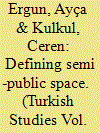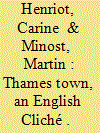| Srl | Item |
| 1 |
ID:
169054


|
|
|
|
|
| Summary/Abstract |
Urban space is accepted as an inextricable part of public life. It is assumed that the upper-middle class has been sequestering itself from the rest of society by living in enclosed and private spaces. This intentional disengagement from public life and public spaces has been studied by the literature on gated communities. This article operationalizes the gated community beyond the debate on social segregation and includes it in the discussion of the use, production and transformation of urban spaces along with the isolation, privatization, and idealization of a specific place. This study departs from the understanding that the gated community is simply a new form of social segregation. Instead, it acknowledges enclosed residential areas as semi-public spaces in which attributes of public and private spaces are merged.
|
|
|
|
|
|
|
|
|
|
|
|
|
|
|
|
| 2 |
ID:
152169


|
|
|
|
|
| Summary/Abstract |
This article contributes to the development of a reading grid for the globalisation of urban models and their hybrid forms through an analysis of the urban production and social construction of a district in the suburbs of an emerging Chinese metropolis based on a casestudy of Thames Town, located in the new city of Songjiang, to the south-west of Shanghai. First, this contribution gives an account of the circulation of internationalised urban planning models and practices and the local development of public-private growth coalitions, that is to say, the establishment of new configurations of players promoting “urban marketing” both at the level of the Shanghai Municipality and that of the District of Songjiang. Secondly, this urban creation with its borrowed architectural forms raises questions with regard to both its morphology and its social reception/construction. The “Town on the Thames” presents a meticulous English-style layout that crystallises the tensions encountered in Chinese urban peripheries: gated communities, the staging of Western architectural styles and their appropriation by the inhabitants, the identity enhancement they represent, and over and above this, relationship of the self to others and of others to the self. What do these districts with their Western-style architecture teach us about the way Shanghai, a metropolis that wishes to transmit its own model of Chinese urban planning, thinks, produces, and appropriates the Chinese city?
|
|
|
|
|
|
|
|
|
|
|
|
|
|
|
|